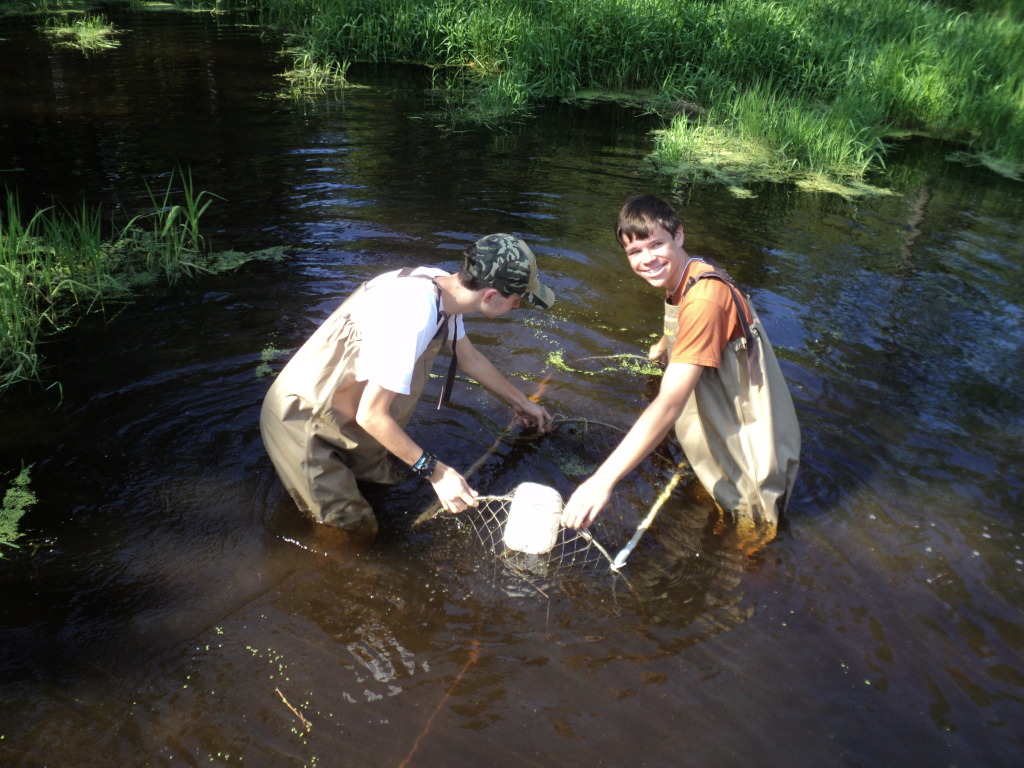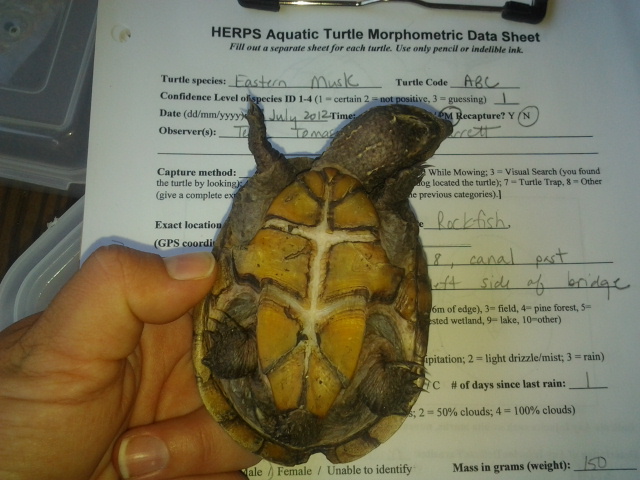Herpetology Education in Rural Places & Spaces - The HERP Project
The HERP Project is a collaborative, statewide informal science education project directed by faculty from three institutions of higher education: PIs Catherine Matthews, Ann Somers, and Heidi Carlone (University of North Carolina Greensboro), PI Terry Tomasek (Elon University), and PI Andy Ash (University of North Carolina Pembroke). The HERP Project is funded by the National Science Foundation (DRL-1114558). The project was created to provide opportunities for the general public, high school students, and secondary school teachers to learn about and collect scientific data on common native species of reptiles and amphibians in local habitats.
The HERP Project has several threads, including public events focused on herpetology, residential summer herpetological research experiences (HREs) for high school students and teachers, opportunities to participate in long-term scientific studies (e.g., the box turtle project and a project on the use of ephemeral pools by amphibians), and a science education research thread designed to define identity-related motivations of casual, regular, and enthusiastic participants, and identify the science identity affordances (outcomes and trajectories) of HERP's activities, from triggered identities for newcomers to more enduring identities for developing enthusiasts.
 |
 |
 |
|
Engaging the community through public celebrations
|
Students checking a turtle trap
|
HRE students found and collected scientific data on turtles to add to the central database
|
The HERP Project’s residential programs for 80 high school students and eight teachers each summer provide opportunities for these individuals to participate in and collect data on several scientific investigations, including: a box turtle study, aquatic turtle studies at several lakes, studies of ephemeral pools, a snake study, a stream amphibian study, a lizard study, and a frog call survey. Students and teachers accompany science and science education researchers into the field to collect data for these projects. Data are collected using mobile devices and apps developed specifically for The HERP Project. The data are then uploaded both to the project database as well as to the Carolina Herp Atlas, a citizen science database of amphibians and reptiles (collectively referred to as herps) found in the Carolinas. This website, hosted by Davidson College, is partially supported by The HERP Project. All participants are encouraged to become active members of this data-reporting site.
In addition to these intensive summer research experiences, or HREs, students continue to learn about statewide herps with field trips offered throughout the school year. Selected HRE participants spend a weekend on the North Carolina coast studying sea turtles, diamondback terrapins (an estuarine species), and other frog, snake, and lizard species that are different from those found in the central part of the state. Other HRE participants spend a weekend in the North Carolina mountains studying salamanders unique to specific mountainous areas. Many HRE participants attend a professional meeting of the North Carolina Herpetological Society and serve as docents at the annual Reptile and Amphibian Day at the North Carolina Museum of Natural Sciences; attendance at this event has been as high as 16,000 visitors.
Amy Germuth of EvalWorks, LLC is the external evaluator for The HERP Project. Formative evaluation of the project is currently underway, and some of the data collected in 2012 will also be used for summative evaluation of outcomes and impacts. Findings across the various threads indicate that all participants surveyed at Celebrations had positive experiences. The interactive, hands-on nature of the activities appealed to participants who also valued that there were a number of events from which to choose. Adults and youths alike enjoyed the opportunity to learn more about herpetology and they heard the message that herps are important and must be protected. Celebration participants had these things to say about their participation in this event:
- “I have been reinforced in my ideas that people still care about our environment and am encouraged to continue our work in trying to make a difference.” (Celebration participant, Age 13)
- “[I learned that] you have to use [a] soft cushion to trace [a] snake and measure it with string.” (Celebration Participant, Age 4)
- “[Reptiles and amphibians] are indicator species--if they are in trouble, so are we.” (Celebration Participant, Age 70)
- “During this [HRE], I've learned to step out of my comfort zone and try new things, like chasing frogs and touching snakes, which I would have never done.”
- “I didn’t think I would ever mark a turtle. I’d be scared that it’d bite me. So, I think that surprised myself. I actually marked a turtle and wasn’t so worried about it. I knew it was for our research, so it was actually helping the turtles.”
- “It was fun because I got to do a lot of things that I would have never done at all. Like I would have never been hiking through woods or holding turtles or in vernal pools, so it was really fun to do something I haven’t done before.”
Collecting baseline data on local amphibians and reptiles is authentic scientific work. HERP project leaders feel it is critical--as society struggles to better understand climate change--that we know our common species and have an idea about their local abundance. Long-term baseline data on herps is lacking because many herp species have either fossorial lifestyles (they spend much of their lives underground) like salamanders and snakes, or have secretive nocturnal lifestyles, like frogs. Long-lived reptile species like turtles, or sensitive skin-breathing amphibians like frogs, are good indicator species of environmental changes. The HERP Project has been partnering with the North Carolina Museum of Natural Sciences to collect important voucher specimens from underrepresented areas of the state. In one summer of research, project participants have already contributed seven species to the museum’s collection, one of which had not been previously reported in the county where it was collected.
The HERP Project promotes herpetological education to the community through a website, The HERP Project Cyberhub, blogs, and outreach events called Celebrations. As part of Celebrations, participants may engage in a statewide interview project documenting North Carolinians’ experiences in nature called Nature Chronicles. Similar to NPR’s Story Corp, Nature Chronicles offers family members the opportunity to interview each other about events involving herps. In addition, at a Celebration, children and adults of all ages have the opportunity to learn about the scientific research being conducted across the state and they learn about data collection techniques from our HRE students (e.g., how to measure a turtle shell with calipers or how to weigh a frog with a Pesola scale). Celebration participants can also watch puppet stories about reptiles and amphibians, and guided nature hikes are offered to help attendees learn about the environments where local herps live.
The HERP Project staff has shared their work this past year with audiences at the North Carolina Science Teachers Association, Environmental Educators of North Carolina, North American Association of Environmental Education, Association of Southeastern Biologists, and the World Congress of Herpetology. Additionally, you can read about the project’s work in the following publications: Green Teacher 96, 36 – 40, Herpetology for High School Students; Children, Youth and Environments, 21 (1), 228-242, A Home for Herps Is Also a Place for People; Science & Children, 38-42, Thinking like a Ssssscientist; and coming soon in NSTA’s Exemplary Science Programs (ESP) Monograph on Professional Development: Professional Development and Authentic Science Education: Monitoring Local Populations of Reptiles and Amphibians.
Pre-post assessments of high school students who participated in the HREs indicated that they learned both valuable scientific skills (e.g., measuring, weighing, and dissecting road killed herps), as well as knowledge about herps’ life cycle development and habitats. HRE participants made the following comments when interviewed at the conclusion of their HRE:
- “During this [HRE], I've learned to step out of my comfort zone and try new things, like chasing frogs and touching snakes, which I would have never done.”
- “I didn’t think I would ever mark a turtle. I’d be scared that it’d bite me. So, I think that surprised myself. I actually marked a turtle and wasn’t so worried about it. I knew it was for our research, so it was actually helping the turtles.”
- “It was fun because I got to do a lot of things that I would have never done at all. Like I would have never been hiking through woods or holding turtles or in vernal pools, so it was really fun to do something I haven’t done before.”
Nature Chronicles participants expressed enjoyment of the activity and identified ways in which it helped them better understand their relationship to nature or further interested them in herpetology. After a successful first year, The HERP Project is currently refining the HREs, Celebrations, and the Cyberhub, and recruiting and training new participants for the Box Turtle Study. Mobile app development continues and project leaders are making progress on our herp recognition software, which will be available at no charge on the project website. The HERP Project staff continues to form new collaborations, works to strengthen outreach to underserved audiences, and recruits new students and teachers for the 2013 HREs. Anticipated results include increased numbers of people, particularly younger ones, participating in herp monitoring activities, and increased participant knowledge, skills, interest, and involvement in herpetology. The project’s study of youth’s science identity continues with data collection, data analysis, and writing for publication. In 2013, the project organizers expect another productive and rewarding season, with three Celebrations and three HREs.